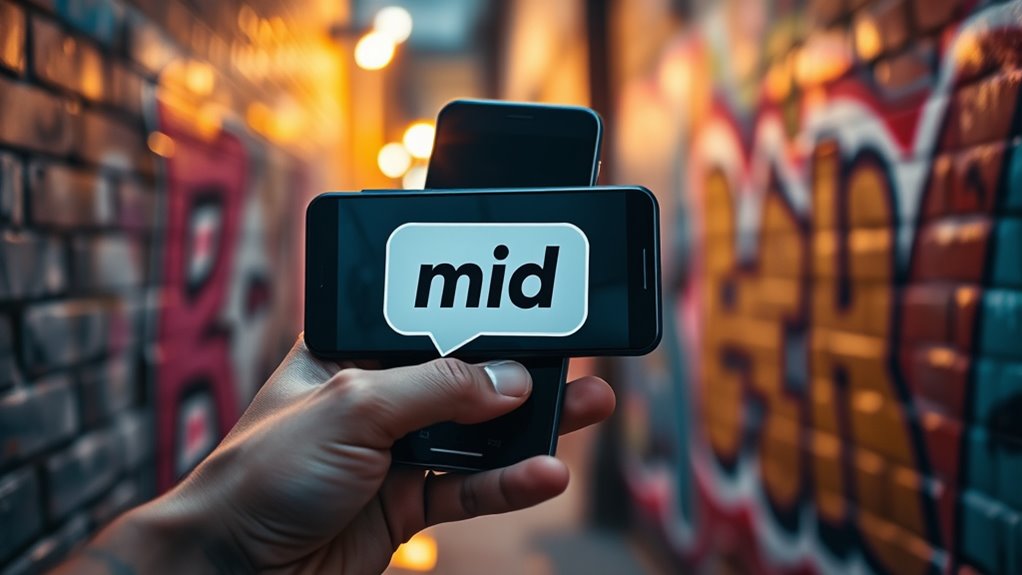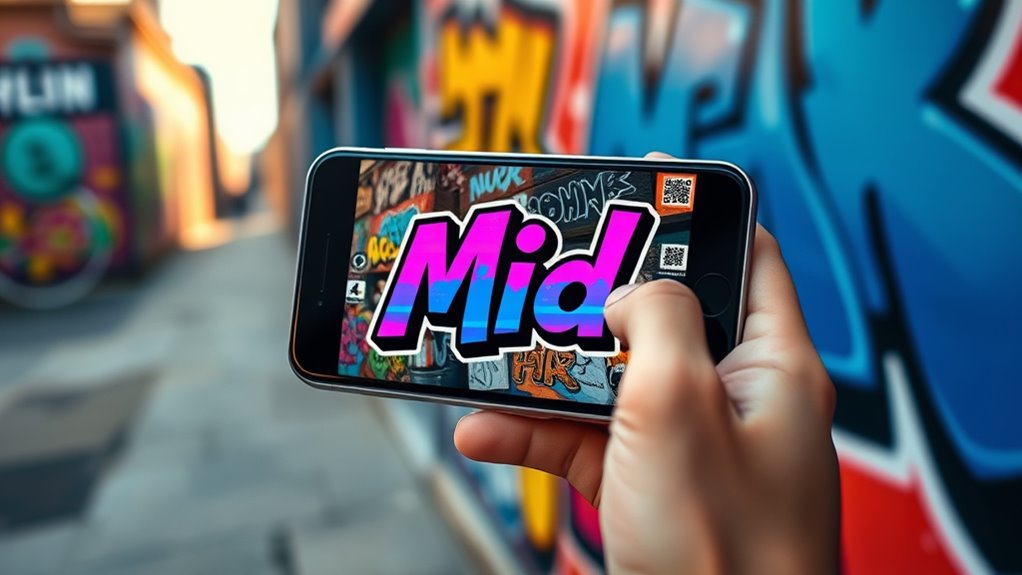“Mid” in slang means something is mediocre or average—neither good nor bad. People often use it to describe music, movies, or experiences that are just okay. It’s popular on social media for quick, honest critiques. Understanding how “mid” reflects trends and youth culture can help you see why it’s so commonly used. To get a fuller picture of its origins and nuances, exploring further will give you even more insight.
Key Takeaways
- “Mid” in slang refers to something being mediocre, average, or just okay.
- It originated from “middle” or “mediocre” and evolved to express neutral or unimpressive quality.
- Commonly used to rate music, movies, or experiences as neither good nor bad.
- Frequently appears in social media and casual conversations to quickly convey indifference.
- Variations include “mid-tier” or “that’s mid,” highlighting a lukewarm opinion.
The Origin of the Term “Mid” in Slang

The term “mid” in slang originates from its use as a shorthand for “middle” or “mediocre,” reflecting something that is neither good nor bad. Its history of slang shows how words evolve over time, shaped by cultural and social shifts. Originally, “mid” simply described the middle point or average quality, but now it has taken on a broader meaning in modern slang. The linguistic evolution behind “mid” illustrates how language adapts quickly, especially within youth culture and online communities. You’ll notice that “mid” has become a versatile term, often used to describe anything that’s just okay or unimpressive. This shift highlights how slang continually transforms, reflecting the changing ways people communicate and assign value to things around them.
“Mid” as a Descriptor for Quality

When people use “mid” to describe quality, they’re signaling that something is neither impressive nor terrible but falls somewhere in the middle. This usage reflects slang evolution, where words shift in meaning based on context and cultural trends. Over time, “mid” has become a popular way to quickly rate things like music, movies, or experiences as average or mediocre. Its rise aligns with linguistic trends favoring brevity and straightforwardness, making it an easy shorthand for expressing a neutral opinion. Instead of praising something as great or criticizing it as bad, calling it “mid” conveys that it’s just okay, not worth getting overly excited about. This trend highlights how slang continuously adapts to reflect collective attitudes and social cues.
How “Mid” Is Used in Social Media and Messaging

You’ll notice that “mid” pops up often in social media and messaging, usually to describe something average or unimpressive. The tone can be casual or even dismissive, implying a lack of excitement or quality. Understanding how “mid” is used helps you grasp the underlying attitude and social context in online conversations. Recognizing well-being tips can also influence how people perceive content quality.
Common Contexts of Use
Have you ever come across “mid” in social media posts or messages and wondered what it means? In digital communication, “mid” is often used to describe something that’s average or unimpressive, especially in casual chats. Its slang evolution reflects how people now quickly share opinions about entertainment, like movies, music, or outfits, using “mid” to signal mediocrity. You’ll see it in comment sections, tweets, or memes when users critique content or express indifference. This slang term is popular because it’s short, punchy, and easy to incorporate into everyday conversations online. Whether you’re rating a song or a game, “mid” helps you communicate a straightforward feeling without lengthy explanations, making it a common feature in social media culture.
Tone and Implications
In social media and messaging, “mid” carries a subtle but clear tone of indifference or mild critique. It reflects the slang evolution, where users express dissatisfaction or disinterest without outright negativity. The linguistic implications show how “mid” signals a neutral or slightly dismissive attitude, often implying something is average or unimpressive. Here’s a quick look:
| Context | Tone | Audience Reaction |
|---|---|---|
| Comparing content | Slightly dismissive | Encourages critique or indifference |
| Expressing quality | Neutral to negative | Signals mediocrity |
| Responding to updates | Mild disapproval | Maintains social harmony |
| Sharing opinions | Subtle critique | Reflects evolving slang meaning |
Additionally, the use of “mid” demonstrates linguistic evolution in online communication, where subtle cues convey complex attitudes.
The Cultural Context Behind “Mid”

The cultural context behind “mid” reveals how slang evolves alongside youth identity and social media trends. As language trends shift, slang like “mid” reflects changing perceptions and values among younger generations. You’ll notice that slang evolves quickly, often mirroring popular culture and social influences. “Mid” gained popularity because it succinctly captures a shared sentiment about quality, fitting into the fast-paced, image-conscious online environment. Social media amplifies these language trends, allowing slang to spread rapidly across platforms like TikTok and Twitter. This constant evolution shapes how you and others communicate, making slang like “mid” a mirror of current youth culture. Understanding this context helps you see how slang serves as a dynamic expression of identity and social belonging. Additionally, the use of aesthetic design elements in home decor reflects how visual trends influence language and cultural expression.
Variations and Related Terms to “Mid”

Are there different ways to use or modify the term “mid” in slang? Yes, as slang evolves, people create variations and related terms to express similar ideas. For example, “mid” can be combined with other words, like “mid-tier” or “mid-level,” to specify different degrees of mediocrity. Some use “mid” as a standalone adjective, while others might say “that’s mid” to indicate something is average or unimpressive. The linguistic origins of “mid” trace back to its basic meaning of “middle,” but its slang evolution has expanded its usage. Variations often reflect regional or cultural differences, allowing the term to adapt and stay relevant. For instance, the semantic evolution of “mid” demonstrates how slang terms can shift from literal to more nuanced meanings over time. Understanding these related terms helps you navigate slang conversations more effectively.
Differences Between “Mid” and Other Slang Terms

While “mid” often signals something mediocre or average, it’s important to recognize how it differs from other slang terms with similar meanings. Unlike words like “basic” or “meh,” which express mild disapproval or indifference, “mid” specifically describes something that’s neither good nor bad but simply average. As slang evolves, these terms reflect subtle nuances in how people perceive quality. “Mid” has gained popularity through language trends driven by social media and youth culture, highlighting how slang shifts to fit current expressions. Understanding these differences helps you grasp the subtleties in conversations, showing how language trends shape the way we communicate attitudes toward things that don’t quite stand out but aren’t outright disappointing either. Additionally, the term’s usage can be influenced by personality traits like the Sanguine’s optimistic outlook, which might lead someone to describe a situation as “mid” if it fails to excite or impress.
Common Scenarios Where “Mid” Might Appear

You’ll often see “mid” used in social media posts when people describe the quality of something, like a movie or meal. It also appears in casual conversations when friends give quick opinions or reactions. Recognizing these scenarios helps you understand how “mid” fits into everyday language. Additionally, “mid” can sometimes refer to a temporary effect of products like eye patches, indicating that the results are not permanent but offer brief improvements.
Social Media Contexts
On social media, “mid” often appears in comments, captions, and memes to quickly express that something is mediocre or unimpressive. It’s a shorthand that reflects slang evolution, often used in response to pop culture references like music, movies, or viral trends. You’ll see it when someone posts a photo of a new release or a snack and adds “mid” to signal it’s just okay. This quick slang captures the shift in online communication, making it easy to share honest opinions without verbosity.
| Scenario | Example |
|---|---|
| Reviewing music or movies | “That album was pretty mid.” |
| Commenting on trends | “That meme was kinda mid, not gonna lie.” |
| Reacting to food pics | “This burger looks mid compared to the hype.” |
| Sharing opinions on content | “Their new video was mid, expected more.” |
Casual Conversations
Ever find yourself casually chatting with friends and wondering how to honestly rate something without sounding harsh? That’s when “mid” often comes up, reflecting the slang evolution and changing language trends. You might hear someone say a movie was “mid,” meaning it was just okay, not great. It’s a common way to express mediocrity subtly. In everyday conversations, “mid” can appear in various scenarios:
- Reviewing a new restaurant experience
- Giving a quick opinion on a song or album
- Discussing a recent sports game
- Rating a clothing item or style
- Commenting on a TV show or movie scene
- Recognizing the importance of honest feedback in social exchanges to maintain authenticity
Using “mid” keeps things casual and honest, fitting right into the ongoing slang evolution and language trends in social chats.
Tips for Using and Understanding “Mid” Correctly

Wondering how to use “mid” correctly in slang? To do so, stay aware of slang evolution and current linguistic trends. “Mid” is often used to describe something that’s mediocre or average, but context is key. When you hear someone say a song or a movie is “mid,” they mean it’s not particularly good or bad—just okay. To use it correctly, avoid overusing “mid” in casual conversations, and pay attention to how others incorporate it into their speech. Remember, slang shifts quickly, so understanding the subtle nuances helps you stay relevant. Keep up with online communities and social media to see how “mid” and similar terms evolve. Additionally, understanding headphones compatibility can enhance your overall audio experience, especially when using different devices or platforms. This awareness guarantees you use “mid” accurately and interpret it properly in different contexts.
Frequently Asked Questions
Is “Mid” Considered a Compliment or an Insult?
“Mid” is generally seen as an insult or negative slang comparison, meaning something is mediocre or average. You might hear people say something is “mid” when they think it’s not impressive or below expectations. Its linguistic origins trace back to slang comparisons, often used to dismiss quality. So, rather than a compliment, calling something “mid” usually indicates disappointment or lack of enthusiasm about it.
How Has the Meaning of “Mid” Evolved Over Time?
Think of slang as a chameleon, constantly changing to fit its environment. Over time, the meaning of “mid” has shifted from simply describing something as average to a more layered term reflecting cultural shifts. Its evolution of slang mirrors society’s attitudes, turning from neutral to subtly dismissive or even humorous. You’d say, “It’s a sign of how language evolves with us,” highlighting how slang adapts alongside cultural trends.
Can “Mid” Be Used in Professional or Formal Settings?
You shouldn’t use “mid” in professional or formal settings, as it’s considered slang and informal. It’s appropriate for casual conversations among friends or online chats where relaxed language is acceptable. In professional communication, stick to more precise and respectful language to maintain credibility. Using slang like “mid” in formal contexts can come across as unprofessional or disrespectful, so choose words carefully based on the setting and audience.
Are There Regional Differences in How “Mid” Is Understood?
Think of “mid” as a weather vane, shifting with regional slang variations influenced by cultural currents. In some areas, it signals mediocrity, while in others, it might hint at something just okay. These differences reflect local tastes and attitudes, shaping how people understand “mid.” So, yes, your interpretation of “mid” can vary based on where you are, influenced by the unique cultural influences that mold regional slang.
What Are Some Common Phrases or Expressions With “Mid”?
In teen slang and gaming terminology, you’ll hear phrases like “That game was mid,” meaning it was average or unimpressive. You might also say, “Don’t bother, it’s mid,” to express disappointment. Other expressions include “mid-tier” for something of mediocre quality and “mid-game” referring to the middle phase of a game. These phrases show how “mid” is used to describe things that are neither great nor terrible.
Conclusion
Understanding “mid” helps you stay current with slang. For example, if a friend says a movie was “mid,” they mean it was average, not great. Recognizing this can prevent misunderstandings and help you connect better in social media chats or casual conversations. Just remember, “mid” is all about describing something that’s neither good nor bad, so use it to express honest opinions and stay in the know with modern slang.









